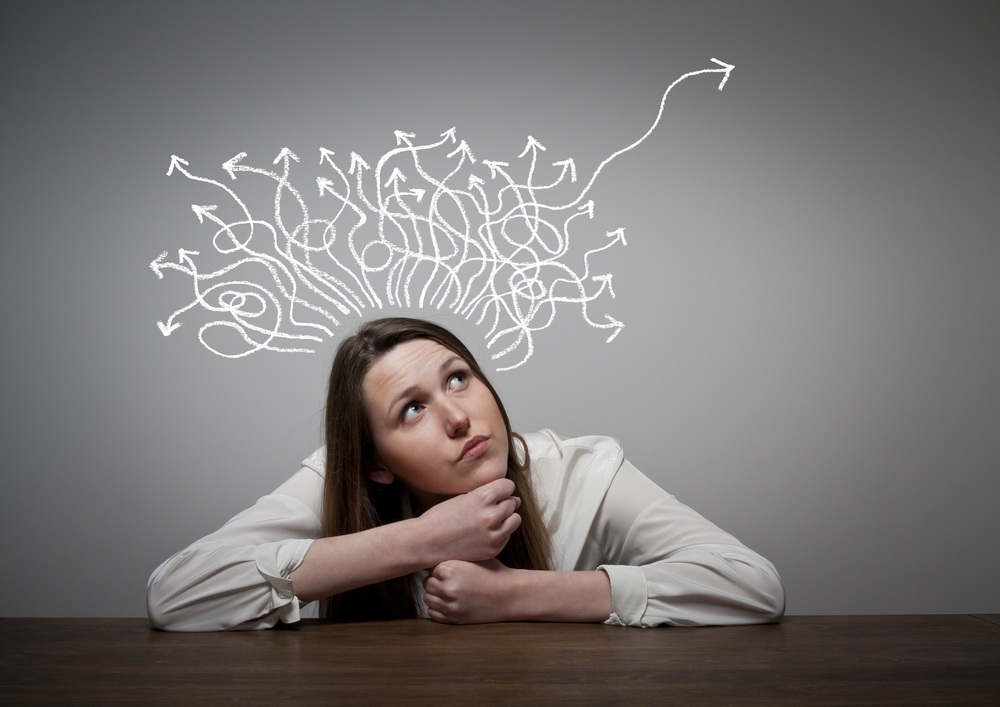Last Updated:
April 1st, 2025
Every person has an inner voice that influences the decisions they make in moments of uncertainty. At times, you may have wondered, “Is this voice here to provide me with guidance, or is this my anxiety toying with me?”
Through practicing ways to discern intuition from anxiety you may be able to hear what your inner voice truly wants you to hear.
This article looks at the key differences between intuition and anxiety and the areas where the two may overlap. We’ll provide practical activities to help you cultivate intuitive thinking and manage the deceptive voice of anxiety.
Conceptualising intuition
Intuition can be understood as a thought process that happens without us needing to weigh up a decision or apply strict, meticulous logic. Our intuition acts as an intangible sense of which choice is the right one to make. Our parents pray that we follow our intuition when we’re at a crossroads and our intuition can provide a guiding light when we don’t know where to turn. In general, intuition serves us for a positive reason and we try to use it to reach a healthy outcome.
You may have heard your intuition expressed to you as trusting your “gut feeling,” or “instincts.” Intuition is, by its nature, subjective and differs from person to person. It can be partly or wholly influenced by our culture, our upbringing or religious background, our past experiences, or even our dreams.
While a strong intuitive sense serves to lead us in a desired direction, it is not always the case that intuition is the only force we should follow. It is possible to lose jobs, relationships or indeed lives by only following intuition, so in many ways, intuitive thoughts should be considered alongside other feelings after weighing up potential outcomes.
We may not be able to see, hold, or feel our intuition, but every person can recognise the potential of strong intuition, influencing our choices and shaping our perceptions of the world.
Understanding anxiety
While we strive to improve our intuition and use it as a force for good, we understand anxieties as a driving force for negative outcomes. Anxiety is characterised by feelings of dread, worry and unease and serves as a response to stressful situations.
Unlike intuition, anxiety can feel completely overwhelming and incessantly repetitive. It makes our hands clammy and our bodies start to sweat. The driving force of anxiety can hold a person back from starting a conversation with a stranger, from asking for a raise even when it’s deserved, or from saying “no” to taking a drug, succumbing to peer pressure.
While a certain amount of anxiety is a natural reaction to a perceived threat, persistent anxiety can indicate that a person suffers from an anxiety disorder. Anxiety disorders are devastating for a person’s self-confidence and can be an unrelenting source of torment if left unaddressed.
Where anxiety and intuition overlap
If we visualise our internal feelings as a landscape, we may be able to see that anxiety and intuition indeed share some common ground.
Both intuition and anxiety can trigger bodily sensations, like a racing heart or uneasy feeling in the gut. When you’re in an unfamiliar situation, both can make you feel doubtful. Your past experiences or traumatic events can further blur the lines between anxiety-driven responses and genuine intuitive signals.
In this way, we can understand how both intuition and anxiety can be aspects of mental health that help us deal with danger and decision-making.
“Risk” as an inherent property of intuition
The source or wellspring of intuitive feelings is much debated by psychological researchers, as has its use and practical application. The highly influential Handbook of Intuition Research states, “For decades, psychologists have viewed intuition as primarily irrational and unreliable.”
As much as we feel that following our intuition should result in the greatest outcome, the fact that intuition is not grounded in rational reasoning and cannot always be relied upon illustrates the inseparable connection between intuition and risks in the real world. There will always be an element of risk in the decisions we make to enhance our lives, so in a perfect scenario, we would always know when our inner voice is part of our genuine intuition or is the result of baseless anxiety.
How to practice distinguishing intuition from anxiety
If you’re struggling with uncomfortable thoughts and feelings and you’re not sure whether it stems from intuition or anxiety, here are some practices to help gain clarity:
Give the feeling time
In general, your intuition will not make you feel rushed or forcefully pushed. Within the nature of intuition is a sense of peace, calmness and a greater good, even if it is suggesting a difficult choice. Conversely, anxiety will present itself from a place of fear and create feelings of urgency. If you give yourself honest time for deep reflection, you may see that anxiety can trick the mind into thinking “I need to act now, or something terrible will happen.” Make sure you’re giving enough time to respect an important decision. You might find that the calmness of intuition remains steady over time, whereas anxiety changes, fluctuates or fades away.
Practicing mindfulness
Psychologists believe that through the practice of mindfulness and self-awareness, we may in fact be able to hone and refine our intuitive senses. It is suggested that mindfulness and intuition have a “symbiotic” relationship, meaning each one complements the other. A mindful person may be able to follow social cues more closely and be more adept at tasks requiring problem-solving skills.
Start with very basic but well-recognised mindfulness activities, such as the “raisin exercise.” Activities focused on recognising the present moment may help you distinguish when you’re experiencing conflicting inner thoughts and are unsure if it’s your intuition or anxiety. Practicing mindfulness may help you reach an “inner stillness” and clarity, quieting inner chaos and allowing a stronger discernment between intuition and anxiety
Talk with loved ones or professionals
Our final recommendation is to make sure you don’t self-isolate or forget that there is help available. Spending too much time alone can lead you to catastrophise your thoughts. This can be especially dangerous for a person suffering from an addiction. Sometimes, just saying your thoughts out loud can make it easier to hear the message your inner voice is trying to tell you.
If you don’t have loved ones you can open up to, taking part in therapy can help you deal with difficult and recurring thought patterns. Therapists can help you recognise unhelpful thoughts through cognitive behavioural therapy (CBT) and provide clarity. Therapy can become the safe space you need to explore your internal monologues. Coping strategies can help you manage anxiety more effectively, stopping it from interfering with intuitive signals.
I need help with an addiction in my life
Anxiety is a symptom inherent to almost every substance addiction. Anxieties can stop you from entering rehab and getting the help you need, so learning to tell the difference between anxiety and intuition may be a pivotal step.
If you or a loved one is struggling to escape the confines of addiction, we want you to know that we can help.
Here at UKAT, we speciailse in addiction and mental health treatment that helps you regain control over your life. Our expert staff are trained to help you manage physical and emotional withdrawal symptoms. Our evidence-based therapy treatments work alongside detoxification to keep you physically and mentally strong. Aftercare is in place to make sure both you and your loved ones remain supported in your lasting recovery.
The help you need may only be one phone call away. Contact us today to start your journey to complete recovery.
(Click here to see works cited)
- Penninx BW, Pine DS, Holmes EA, Reif A. Anxiety disorders. Lancet. 2021 Mar 6;397(10277):914-927. doi: 10.1016/S0140-6736(21)00359-7. Epub 2021 Feb 11. Erratum in: Lancet. 2021 Mar 6;397(10277):880. doi: 10.1016/S0140-6736(21)00473-6. PMID: 33581801; PMCID: PMC9248771.
- Sinclair, Marta. “Handbook of Intuition Research.” Handbook of Intuition Research, Edward Elgar Publishing, 2011.
- “Mindfulness: The Tuition of Intuition.” Psychology Today, Sussex Publishers, www.psychologytoday.com/us/blog/sexual-mindfulness/202401/mindfulness-the-tuition-of-intuition
- Swaminathan, Abirami & Rathnasabapathy, Dr. (2024). Role of Intuition on problem solving style – mediating effect of mindfulness. MethodsX. 13. 103067. 10.1016/j.mex.2024.103067.
- (PDF) Development and Validation of a New Measure of Intuition: The Types of Intuition Scale, www.researchgate.net/publication/262388029_Development_and_Validation_of_a_New_Measure_of_Intuition_The_Types_of_Intuition_Scale
- Courtney E. Ackerman, MA. “21 Mindfulness Exercises & Activities for Adults.” PositivePsychology.Com, 21 Feb. 2025, positivepsychology.com/mindfulness-exercises-techniques-activities/.
- Albert Bonfil, PsyD. “Cognitive Distortions Definition of Catastrophizing.” Cognitive Behavioral Therapy Los Angeles, Cognitive Behavioral Therapy Los Angeles, 23 Oct. 2023, cogbtherapy.com/cbt-blog/cognitive-distortions-definition-of-catastrophizing.




